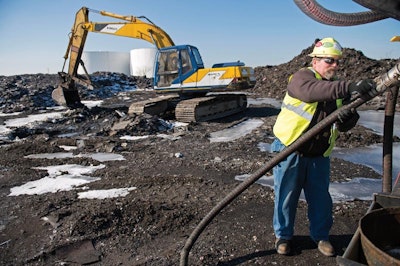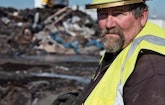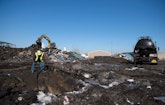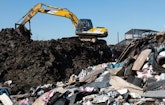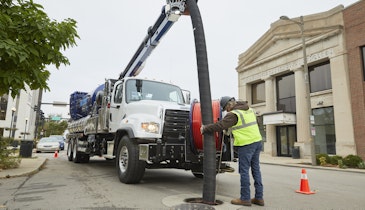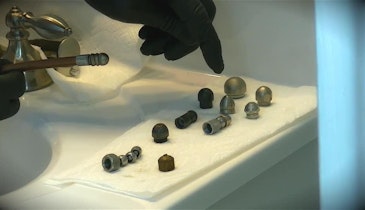Interested in Cleaning?
Get Cleaning articles, news and videos right in your inbox! Sign up now.
Cleaning + Get AlertsService is a top priority for North American Construction, which has made its name by providing 24/7 emergency response, working on tight schedules, meeting deadlines and overseeing highly sensitive environmental issues.
Kent Ferguson founded the company after running his own engineering firm for eight years. He eventually determined the construction end of the business would be more profitable.
“We had worked with 24 counties in Indiana,” Ferguson says. “This was our target base for the new venture, but our client base expanded exponentially. Our first project was with Rock Island Refining Corporation, now Marathon Petroleum Company. We were there to demolish 15-foot-deep pylon footings that had been in place since the original construction of a building in 1945. These had to be removed so they could do other work in the area.”
The client base began to grow and now includes numerous Fortune 500 companies across Indiana. The company’s menu of services also expanded as it added the proper equipment and experienced technicians to tackle new projects.
“From the Rock Island demolition job, we developed the tank cleaning and sludge removal as we expanded into vacuum trucks and began doing almost all of their maintenance,” Ferguson says. “We began working on well abandonment projects in various remediation sites.”
Tough stuff
Ferguson says the company has faced some challenging situations, both in terms of objectives and timelines.
“Some schedules are much tighter than others,” he says. “With any type of turnaround, which is often a giant job where they have shut a facility down, it can be pretty dynamic getting it all up and running from stem to stern again. But it is the same old story. Time is money. Any time the equipment is down is costly. Our job is to save our client millions of dollars lost in downtime. We want to do this as safely and quickly as possible.”
Emergency calls are usually of a different nature. Ferguson says they might get a call from a school district reporting a waterline out. His team will respond immediately and use hydroexcavation equipment to expose the line for repair or replacement. When the job is complete, they backfill and pour more concrete if needed.
North American generally serves as the prime contractor, working with a client’s engineer as needed. Because the company is so well equipped, it does not subcontract.
“Things seem to work much better if you are in control and are the prime contractor,” Ferguson says. “This way you can set your schedule accordingly.”
The company works with a small number of well-trained technicians.
“We have two-, three- and sometimes four-man crews,” Ferguson says. “And we are able to deal with multiple projects at a time. Although we once had a satellite office, we find it better to work from our Indianapolis base. Our workers are sometimes away from home for short periods of time, but that is rare as we work primarily in Indiana.”
When hiring, Ferguson says he first looks at an applicant’s background.
“If someone has worked for several companies, I would have concerns,” he says. “I know most people in the area and can always follow up for references. We want a person to be safety minded and to pass our very difficult drug program.”
Ferguson describes company culture as very family-oriented and says his door is always open. Because of the company’s challenging work, he puts a considerable amount of trust in his employees to go out and get the job done for North American and their clients.
Leaders on staff include Lonnie Hoskins and Kevin Webb, who have both been with Ferguson for many years. Hoskins has a wealth of emergency response and demolition training and is currently senior project leader. Webb is senior project manager, and brings experience from the refinery business.
Proper disposal
North American Construction has taken on a wide scope of projects, everything from trenching and installing pipe systems to tank cleaning, dredging and waste disposal. They have done on-site bioremediation, and of course various emergency spill response projects.
One very memorable job in 2003 had to do with the Kokomo Gas & Fuel Company’s 387-foot-tall gas holder in Kokomo, Indiana. The 22-sided structure had to be imploded, and because the tank held very flammable oil, North American was contracted to thoroughly clean it. Crews emptied the tank’s contents — 18,000 gallons of sealant oil — and provided proper disposal and recycling.
The cleaning process was extremely complicated because of the tank’s size and design. The tank, which was built in 1954, could hold 12 million cubic feet, but it became obsolete in the 1970s due to new technology.
“We had to clean every nook and cranny of the tank where the oil could be hiding,” Ferguson says. “It was a huge tank that could be seen for miles.”
When it comes to disposal, Environmental Director Dee Snively has set up generic profiles for hydrocarbon contaminated sludges, contact water, septic, grease trap contents and other material. If it does not fit into those profiles, she will collect a sample of the material and analyze it to confirm the waste characterization and find alternative waste disposal options.
“We just finished a project not too long ago where the material was supposed to be clean fill concrete but it was hydrocarbon contaminated. My job is to stop the project and change the order to get it redirected to go to the appropriate facility. Obviously contaminated hydrocarbon concrete cannot go into a lake, for example.”
Home base
North American operates on a 6-acre site with a 10,000-square-foot facility, which includes plenty of space to keep all the company’s equipment indoors and ready to go.
The company’s stable of water blasters, a key component in most cleaning operations, comes from NLB. Crews rely on a 2004 20,000 psi NLB 2012D with an assortment of specialized nozzles, including the StoneAge Barracuda and NLB Spin-Nozzle. The unit has a convertible pump with a quick-change, in-line fluid end design with fewer parts for increased operating efficiency and simpler maintenance. It uses a simple conversion kit to operate at pressures from 6,000 to 40,000 psi. North American sets it for 20,000 psi and uses a variety of nozzles, depending on the job.
North American crews also use four 10,000 psi NLB 1012D machines. They draw additional cleaning power from a trailer-mounted Jetstream Jet Rodder and a 1996 Schmidt Accustrip 12SB ARMEX blaster.
Hydroexcavation is another essential aspect of the company’s work. The firm uses a 1996 Guzzler with a 15-cubic-yard debris tank, and a 1992 Vactor 2045 wet/dry vac truck with a 20-yard debris tank.
The company employs an in-house mechanic and checks all high-pressure lines before starting a project.
High bar for safety
When people in the field work with high-pressure water blasting equipment, safety has to be top priority.
Technicians attend several classes upon joining the company, as well as various follow-up programs that keep them on their toes.
A new hire goes through 10 hours of OSHA training along with a company orientation program that covers lockout/tagout, confined-space entry and electrical safety. Additionally, each new hire must take a behavior-based training class that reinforces safety issues.
Company policy includes constant reminders that employees must take care of one another on the jobs. When an employee observes what could be a life-threatening situation, he learns to take a step back and tell a co-worker, “I want you to come home tonight.”
“That is the kind of reaction we want our workers to encourage,” Ferguson says.
“We do annual Hazwoper training that goes into working in hazardous waste sites and emergency response,” he says. “We don’t put anyone on a gun without going through a tremendous amount of training, watching, assisting, being at the job site. This is very expensive for our company as we don’t charge our customer for the time of a trainee — or shadow person — on the site.”
Ferguson says new hires spend more than six months learning the rigors of work, the importance of communication, how to act as an attendant for confined-space entry and more before working with equipment such as hydroblasters and Vactor trucks. This is physically demanding work and can be dangerous if not fully understood by the technician.
“We are always confident that our workers know the conditions they are dealing with,” Ferguson says. “We can be confident they have been thoroughly trained and are thoroughly skilled in what they are doing.”
